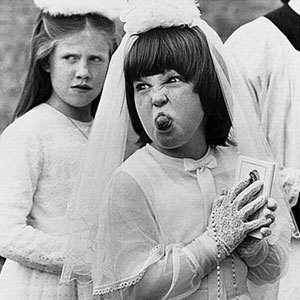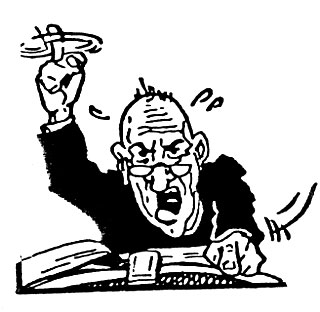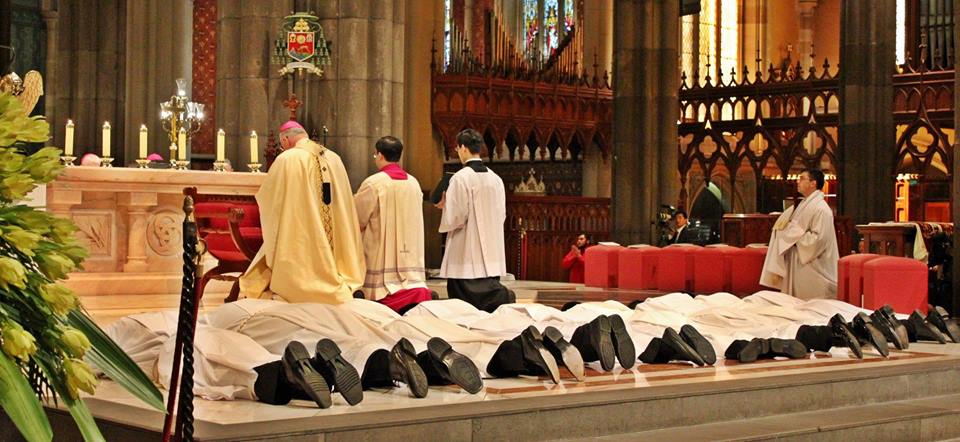Kids never cease to amaze me. I’m speculating, because the option was never proposed to me, but I reckon when I was in grade three, receiving communion on the tongue would have horrified me.
In contrast, the children I’m presently preparing for communion seem to prefer it. With just a few weeks to go, we practised how to receive holy communion today. St Cyril helped out:
Make your left hand a throne for the right, as for that which is to receive a King. And having hollowed your palm, receive the Body of Christ, saying over it, Amen.
I’m conscious of kids not liking wine, and making faces after tasting it, so we also tasted some altar wine today. The reaction was precisely what I expected. “Yuck!”
“Even if you don’t like the taste,” I told them, “remember that it won’t really be wine at Mass. It will look the same and taste the same, but it will be the Precious Blood of Christ. You don’t have to receive from the chalice, but I think it would be a wonderful thing to receive our Lord’s blood on your first communion day.”
So then the negotiations start. “Can’t we dip the bread —” (Fr John clears his throat) “— I mean, can’t we dip the body of Christ into the chalice?”
I guess someone, somewhere, had seen that practice. So I explained to the children that the Catholic Church doesn’t allow that, because the Precious Blood might drip onto the floor. “But in some places,” I added, “the priest dips the host into the chalice, and then he places the Eucharist on your tongue.”
That intrigued them. They all wanted to try it, and having tried it, most of them seemed to prefer it.
I promised them a funny video next week, which explains the dos and don’ts of receiving communion:






I hope I will live to see one day Catholic principals and teachers leading schoolchildren into the Church, putting a finger to their lips, genuflecting and making sure each child follows.
I hope one day to see Catholic principals and teachers and children, who have trooped into the Church to practice some liturgical participation, when they see Our Lord in the Monstrance, fall to their knees and spend at least five minutes in silent adoration, then leave, delaying their practice.
It was distressing to witness recent converts their first Holy Communion without so much as a nod beforehand.
I did see one schoolboy, once, come into the Church after school to pay a visit. He seemed to know Who is in the tabernacle.
I was tempted to take a photo of this miracle.
Father, you have discovered something so beautiful and so true. In a short seven years of teaching in catholic primary schools (thus many experiences of sacraments in schools) I must say that the most reverent reception of First Holy Communion I ever saw was last year, when children came to receive Our Lord from the kneelers. When recently preparing children, I realised why it was so reverent last year… when they receive with their hands there are too many gestures for them to remember, whereas on the kneelers there is only one thing they need to do!
Receiving from the kneelers (a whole- body gesture) helps children understand the sacredness of what they are actually partaking in. You’ll notice when they return to their seats afterwards, they then take the time to continue to kneel and pray. There is a sense of awe, something beautiful they have partaken in, and that sensory encounter has the capacity to take them out of themselves and move them towards the transcendent. The kneelers are unusual, set apart from the mundane or profane. It’s “different” for them and helps them to engage.
Our bishops conference allows for standing or kneeling so I respectfully wouldn’t enforce only one form of receiving communion. However, for their First Holy Communion, I say “bring back the kneelers.” And from what I read about the children in your school, I’d say that they would probably agree!
Amen, Sister!
Kids are great, just love engaging in religious discussion with them. I will show my children the video you posted, very informative information with a humorous touch! thanks Fr John!